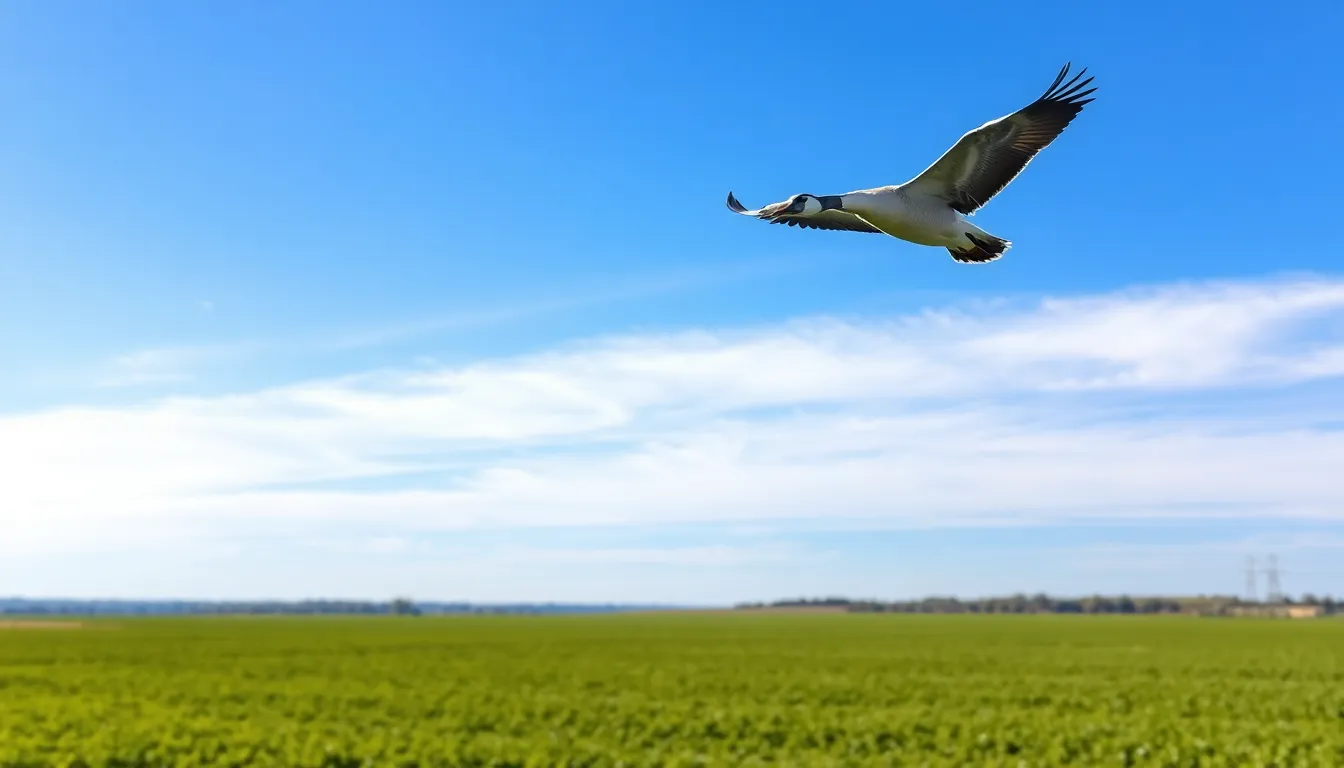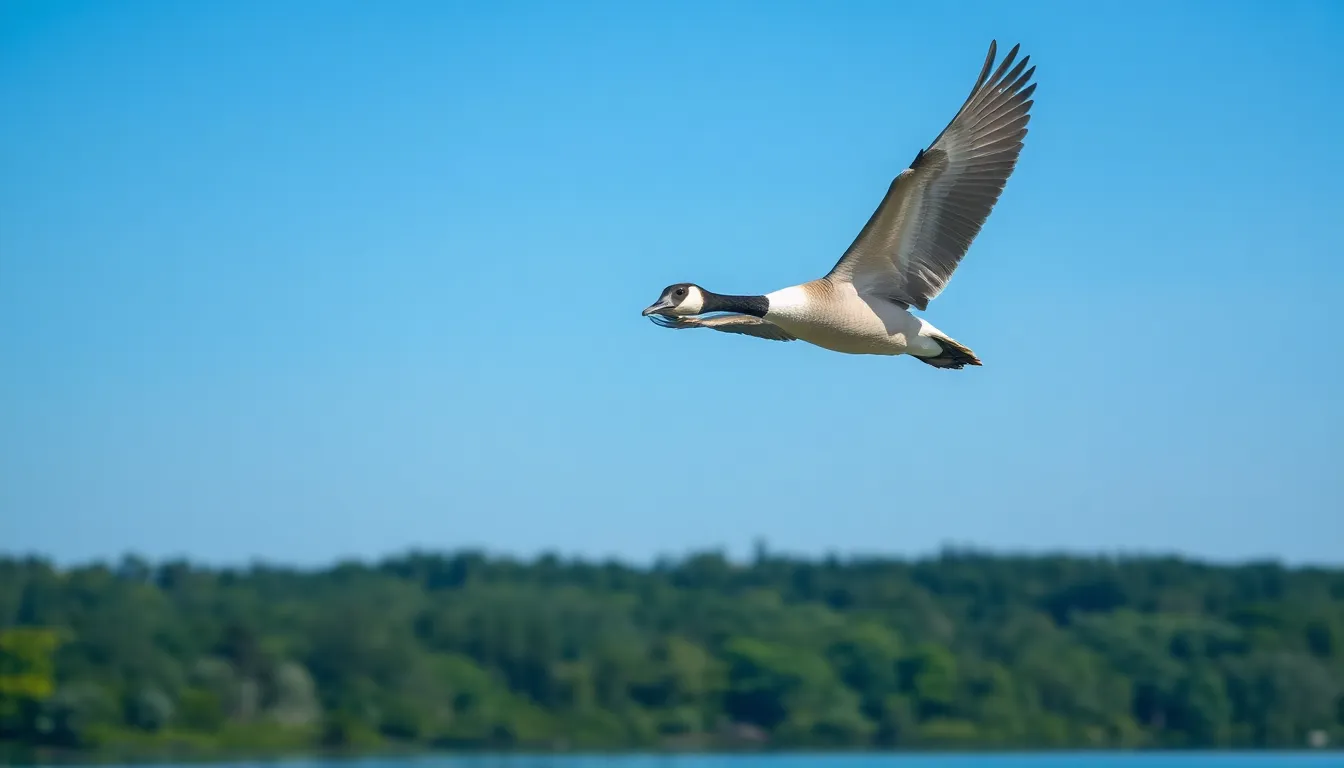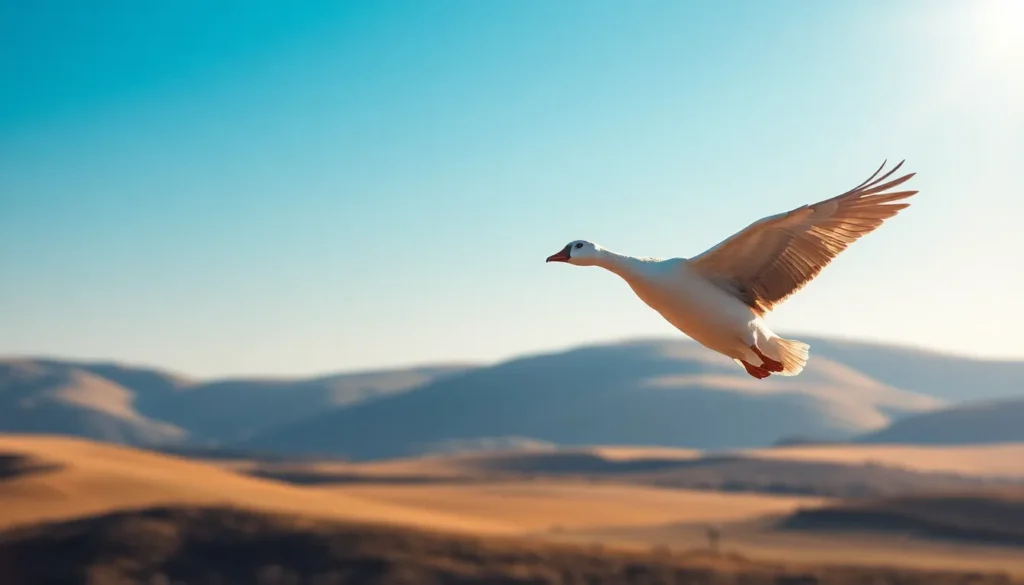Have you ever witnessed a solitary goose flying across the sky and felt something stir deep within your soul? There’s something profoundly moving about seeing this majestic bird journeying alone through the vast expanse above us. When we encounter a lone goose, it’s rarely just a random wildlife sighting – it often carries powerful spiritual significance that speaks directly to our hearts.
In many spiritual traditions and belief systems, the lone goose represents profound messages about independence, determination, and spiritual awakening. These remarkable birds don’t simply wander aimlessly when separated from their flock. Instead, they embody courage, resilience, and the strength to forge their own path when circumstances demand it.
We’ll explore the fascinating spiritual meanings behind encountering a lone goose, from ancient symbolism to modern interpretations that can guide us through life’s most challenging moments. Whether you’ve recently spotted one or you’re drawn to goose symbolism, understanding these spiritual messages can unlock powerful insights for your personal journey.
The Symbolism of Geese in Various Spiritual Traditions
Geese hold profound sacred meaning across many spiritual traditions throughout history. Ancient Egyptian mythology revered geese as messengers between earthly and divine realms, with the Great Cackler goose creating the primordial egg from which all existence emerged. Celtic traditions viewed geese as symbols of warrior spirit and protection, often appearing in tales of heroes embarking on groundbreaking quests.
Native American cultures consider geese powerful spirit animals representing community bonds and seasonal wisdom. Tribes across North America observed migrating geese as indicators of changing seasons and times for spiritual preparation. Shamanic practices incorporated goose medicine for healing rituals focused on loyalty, communication, and family connections.
Hindu scriptures feature Hamsa, the divine goose symbolizing spiritual discrimination and the soul’s journey toward enlightenment. Buddhist teachings interpret geese as representations of mindfulness and the ability to separate truth from illusion. Tibetan traditions specifically honor geese for their capacity to fly at extreme altitudes, connecting earthly existence with higher consciousness.
Christian symbolism associates geese with vigilance and protective instincts, drawing from stories of geese alerting communities to approaching danger. Medieval European folklore portrayed geese as guardians of sacred spaces and symbols of divine providence. Germanic traditions linked geese to fertility goddesses and seasonal celebrations marking agricultural cycles.
Chinese philosophy incorporates geese as symbols of marital fidelity and lifelong partnerships. Feng shui practices use goose imagery to enhance relationship harmony and strengthen family bonds. Japanese culture views geese as messengers of good fortune, particularly when observed during autumn migrations.
| Tradition | Primary Symbolism | Spiritual Association |
|---|---|---|
| Egyptian | Divine messenger | Creation and rebirth |
| Celtic | Warrior spirit | Protection and courage |
| Native American | Community bonds | Seasonal wisdom |
| Hindu | Spiritual discrimination | Soul’s journey |
| Buddhist | Mindfulness | Truth recognition |
| Christian | Vigilance | Divine providence |
| Chinese | Marital fidelity | Relationship harmony |
Contemporary spiritual practices draw from these ancient traditions to interpret lone goose encounters as calls for spiritual independence while maintaining connection to universal wisdom.
What Does a Lone Goose Represent Spiritually?

The lone goose carries profound spiritual significance as a symbol of independence, self-reliance, and personal courage. This solitary bird represents our ability to trust ourselves and navigate life’s journey alone when circumstances require it.
Independence and Self-Reliance
The lone goose embodies independence and self-trust, encouraging us to rely on our instincts and make our own decisions. This powerful symbol teaches us the importance of being self-reliant and confident in our unique path. When we encounter a lone goose, it reminds us that we possess the inner strength to stand on our own and trust our personal judgment. The bird’s solitary flight demonstrates that independence doesn’t equal isolation but rather represents a conscious choice to follow our authentic direction.
Breaking Away from the Flock
Seeing a lone goose can signify breaking away from the crowd and embracing solitude for personal growth. It suggests that sometimes, going against the norm or leaving a familiar group leads to a stronger sense of self and deeper understanding of our purpose. The lone goose represents the courage required to separate from conventional thinking and societal expectations. This symbol encourages us to recognize when conformity limits our spiritual development and empowers us to choose our own path even though external pressures.
Personal Journey and Soul Searching
The lone goose is associated with introspection and self-discovery, inviting us to embark on a journey of personal reflection. This symbol encourages us to explore our thoughts and feelings to understand ourselves better and uncover our authentic nature. The solitary bird represents the importance of spending time alone to connect with our inner wisdom and spiritual guidance. It reminds us to trust our intuition and follow our own spiritual path with courage and determination, recognizing that some journeys must be traveled alone for true transformation to occur.
Common Spiritual Messages from Lone Goose Encounters

Encounters with solitary geese deliver distinct spiritual messages that guide us toward deeper self-understanding and personal growth. These meaningful interactions consistently offer three primary spiritual communications that resonate across different cultural and spiritual contexts.
Call for Inner Reflection
The lone goose serves as a prompt for introspection and self-discovery when it appears in our lives. Encounters encourage us to pause, consider our thoughts and feelings, and reflect on our life direction with greater clarity. This solitary bird reminds us to connect with our inner voice and seek understanding about our personal goals and desires. We receive an invitation to examine our current path and assess whether it aligns with our authentic selves. The presence of a lone goose creates space for meaningful contemplation about our spiritual journey and personal evolution. These moments of reflection often reveal insights that have been waiting beneath the surface of our daily consciousness.
Sign of Upcoming Transition
The image or presence of a lone goose often signals an impending change or transformation in our lives. This may manifest as a personal, emotional, or spiritual shift that requires our attention and preparation. The lone goose’s journey alone invites us to embrace new experiences and adapt to transformation with resilience and determination. We discover that these encounters frequently precede important life changes that push us toward growth and expansion. The timing of these sightings often coincides with periods when we’re standing at crossroads or facing important decisions. Transitions marked by lone goose encounters typically involve moving from dependence to independence or from conformity to authentic self-expression.
Reminder of Personal Strength
The lone goose symbolizes leadership, bravery, and determination through its independent journey and ability to face challenges alone. Its capacity to travel independently and overcome adversity serves as a reminder of the strength that exists within each of us. We’re encouraged to draw on our own inner resolve and trust ourselves during challenging times when support systems may be limited. The lone goose demonstrates that individual power and self-reliance can carry us through difficult circumstances. These encounters reinforce our capability to make decisions independently and stand by our convictions even when others disagree. We learn that solitary strength often becomes the foundation for future leadership and the ability to guide others who face similar challenges.
Lone Goose Spiritual Meaning in Different Cultures

Cultural interpretations of the lone goose vary across traditions yet share common themes of independence and spiritual guidance. Ancient wisdom traditions offer unique perspectives on this solitary bird’s symbolic significance.
Native American Interpretations
Native American cultures regard birds as sacred messengers bridging the human and spirit worlds. These traditions emphasize the spiritual connection between humans and avian guides, viewing them as carriers of wisdom and divine guidance. The lone goose embodies independence and self-reliance within this framework, reflecting themes deeply embedded in Native American storytelling and spiritual beliefs.
Tribal wisdom recognizes the solitary goose as a symbol of inner strength and personal navigation. Many Native American stories feature animals that must journey alone to discover their true purpose, mirroring the lone goose’s solitary flight patterns. This interpretation aligns with the broader Native American understanding of individual spiritual quests and the importance of trusting one’s inner compass.
Celtic and European Folklore
Celtic traditions associate geese with fertility, prosperity, and abundance throughout their folklore. European cultures view these birds as symbols of good fortune and material blessings, often incorporating them into seasonal celebrations and agricultural rituals. The lone goose within this context represents solitude paired with leadership qualities, reflecting the bird’s natural ability to navigate independently while maintaining direction.
Ancient Celtic stories rarely feature solitary geese specifically, yet the symbolism extends to themes of courageous leadership and independent thinking. European folklore emphasizes the goose’s connection to seasonal cycles and natural rhythms, suggesting that the lone goose represents those who march to their own drumbeat while remaining connected to natural law.
Eastern Spiritual Perspectives
Chinese spiritual traditions connect geese with marital fidelity, longevity, and harmonious relationships. These Eastern perspectives view geese as symbols of lasting bonds and faithful partnerships, making them popular motifs in wedding ceremonies and romantic poetry. The lone goose in this context symbolizes independence outside traditional pairings or represents personal spiritual journeys that transcend conventional relationships.
Eastern philosophy recognizes the solitary goose as a representation of individual enlightenment and self-discovery. Buddhist and Taoist teachings often reference birds that fly alone as metaphors for the spiritual seeker who must eventually walk their path independently. This interpretation emphasizes the lone goose’s role as a guide for those seeking personal transformation and spiritual awakening beyond societal expectations.
How to Interpret Your Lone Goose Sighting

We can decode the spiritual messages from a lone goose encounter by examining exact elements of our experience. Proper interpretation requires us to consider context, personal circumstances, and spiritual practices that deepen our understanding.
Context and Timing Considerations
Context plays a crucial role when we encounter a lone goose during important life moments. Our current challenges often align with the timing of these spiritual sightings, creating meaningful connections between the bird’s presence and our personal situations. The season, weather conditions, and location where we spot the lone goose can amplify or modify its spiritual message.
Morning sightings typically indicate new beginnings and fresh perspectives on our independence journey. Evening encounters suggest reflection time and the completion of personal growth phases. Stormy weather appearances emphasize our resilience during difficult times, while clear sky sightings confirm we’re on the right path toward self-reliance.
We must also consider our emotional state during the encounter, as the lone goose often appears when we’re contemplating major decisions or feeling isolated from others.
Personal Life Circumstances
Personal challenges frequently coincide with lone goose appearances, creating opportunities for spiritual guidance and inner strength development. Career transitions, relationship changes, or family dynamics often trigger these meaningful encounters, encouraging us to trust our instincts and embrace independence.
Financial uncertainties or health concerns can make lone goose sightings particularly important, reminding us of our inner resilience and self-trust capabilities. Educational pursuits or creative endeavors also align with these encounters, as the lone goose represents courage to explore unique paths and diverge from conventional choices.
We can assess our readiness for solo journeys by examining our current support systems and determining where we need to develop greater self-reliance. The lone goose reminds us that some life transitions require us to step away from group dynamics and trust our individual judgment.
Meditation and Reflection Practices
Meditation connects us directly with the spiritual guidance that lone goose encounters provide, deepening our understanding of independence and self-trust themes. Quiet reflection sessions allow us to process the emotions and insights that arise from these meaningful sightings.
Journaling about our lone goose experience helps us identify patterns between the encounter and our current life circumstances, revealing hidden connections and spiritual messages. Visualization exercises where we imagine ourselves as the lone goose can strengthen our confidence in making independent decisions.
We can practice mindfulness techniques that focus on the qualities the lone goose represents: courage, determination, and spiritual awareness. Breathing exercises that connect us to our inner wisdom enhance our ability to interpret the spiritual significance of these encounters. Regular meditation on independence themes prepares us to recognize and act upon the guidance that lone goose sightings provide.
Integrating Lone Goose Wisdom into Daily Life

Practical application of lone goose wisdom transforms our spiritual insights into meaningful daily experiences. We can cultivate independence by making conscious decisions that align with our authentic selves rather than following external expectations. Solitude becomes a powerful tool for self-discovery when we dedicate exact time each day to reflect on our thoughts emotions and spiritual growth.
Embracing Solitude for Self-Reflection
Morning meditation sessions create space for introspection and help us connect with our inner guidance. We benefit from sitting quietly for 10-15 minutes daily while focusing on our breath and allowing thoughts to surface naturally. Journaling after these sessions captures insights that emerge during contemplative moments. Walking alone in nature provides another avenue for solitude where we can observe our surroundings while processing internal experiences.
Trusting Your Instincts and Inner Voice
Decision-making becomes more confident when we pause before choices and listen to our gut feelings. We can practice this by asking ourselves what feels right in small daily decisions like choosing meals or selecting routes to work. Physical sensations often accompany intuitive messages with tension indicating resistance and ease suggesting alignment. Recording these experiences in a spiritual journal helps us recognize patterns in our intuitive responses.
Developing Effective Communication Skills
Clear communication strengthens our relationships while maintaining our independent nature. We express our needs directly and honestly without expecting others to guess our intentions. Active listening demonstrates respect for others’ perspectives while staying true to our own values. Setting healthy boundaries protects our energy and allows authentic connections to flourish.
Cultivating Self-Reliance and Personal Responsibility
Taking ownership of our actions and outcomes builds the inner strength that lone goose symbolism represents. We can start by managing our finances independently and making our own healthcare decisions. Learning new skills like cooking home repair or technology increases our self-sufficiency. Accepting responsibility for our emotional responses rather than blaming external circumstances develops emotional maturity.
Creating Sacred Spaces for Spiritual Practice
Designating exact areas in our homes for meditation and reflection reinforces our commitment to spiritual growth. These spaces can include symbols that remind us of lone goose wisdom such as feathers nature photographs or meaningful objects. Regular spiritual practices in these dedicated areas strengthen our connection to inner guidance and spiritual awareness.
Conclusion
The lone goose stands as a powerful spiritual messenger that calls us to embrace our individual journey with courage and authenticity. These encounters remind us that some of life’s most profound transformations happen when we’re willing to step away from the flock and trust our inner guidance.
When we integrate the wisdom of the lone goose into our daily lives we develop stronger self-reliance and deeper spiritual awareness. Whether through meditation journaling or simply spending time in nature we can cultivate the independence and determination that this majestic bird represents.
The next time you spot a solitary goose soaring across the sky take a moment to reflect on what message it might carry for you. Trust that this encounter isn’t mere coincidence but rather a gentle reminder of your own strength and the unique path you’re meant to follow.
Frequently Asked Questions
What does it mean spiritually when you see a lone goose?
Seeing a lone goose spiritually represents independence, courage, and self-reliance. It often signals that you’re being called to trust your inner wisdom and navigate your own path. This encounter may indicate spiritual awakening, upcoming life transitions, or the need for introspection and personal growth.
What are the different cultural meanings of lone geese?
Various cultures interpret lone geese differently. Native Americans see them as sacred messengers symbolizing inner strength. Celtic traditions associate them with fertility and courageous leadership. Eastern philosophies connect them to personal enlightenment journeys. Ancient Egyptians viewed them as messengers between spiritual realms, while Hindu scriptures feature the divine Hamsa goose.
What spiritual messages do lone geese typically convey?
Lone geese commonly convey three primary messages: a call for inner reflection and self-assessment, signaling upcoming life transitions that require resilience, and reminding you of your personal strength and leadership abilities. These encounters often encourage you to trust yourself during challenging times and embrace your authentic path.
How can I interpret my encounter with a lone goose?
Consider the timing, setting, and your personal circumstances when interpreting lone goose encounters. Morning sightings often indicate new beginnings, while evening encounters suggest reflection time. Pay attention to current life challenges, as these sightings frequently occur during times when spiritual guidance is most needed for personal growth.
What practices can help me connect with lone goose wisdom?
Meditation, journaling, and visualization techniques can deepen your understanding of lone goose messages. Spend time in solitude through morning meditation or nature walks. Practice mindfulness to develop spiritual awareness. Create sacred spaces for reflection and trust your instincts when making important life decisions.
How do I apply lone goose teachings in daily life?
Cultivate independence by making conscious decisions aligned with your authentic self. Embrace solitude for self-discovery through regular meditation and journaling. Trust your inner voice in decision-making, develop clear communication skills, and take personal responsibility for your actions. Create sacred spaces to maintain your spiritual practice and connection to inner guidance.







